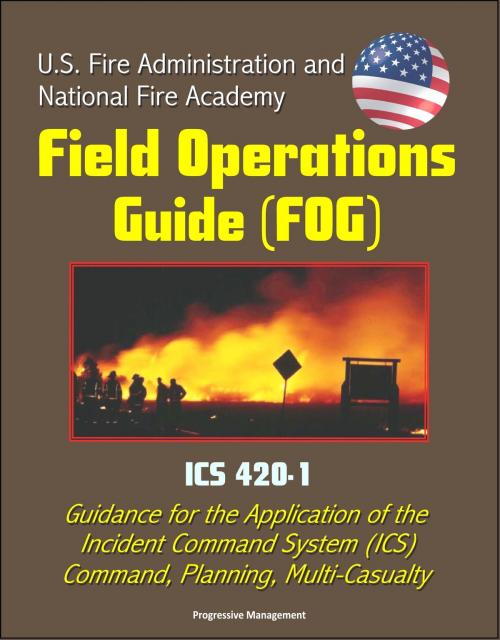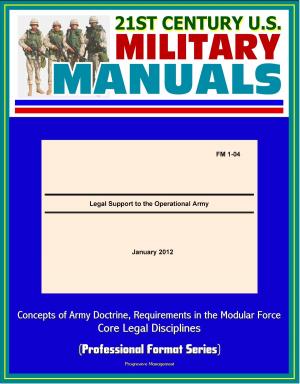U.S. Fire Administration and National Fire Academy Field Operations Guide (FOG) - ICS 420-1 - Guidance for the Application of the Incident Command System (ICS), Command, Planning, Multi-Casualty
Nonfiction, Science & Nature, Technology, Fire Science, Engineering| Author: | Progressive Management | ISBN: | 9781310091148 |
| Publisher: | Progressive Management | Publication: | January 19, 2015 |
| Imprint: | Smashwords Edition | Language: | English |
| Author: | Progressive Management |
| ISBN: | 9781310091148 |
| Publisher: | Progressive Management |
| Publication: | January 19, 2015 |
| Imprint: | Smashwords Edition |
| Language: | English |
The content of the Field Operations Guide (FOG) is intended to provide guidance for the application of the Incident Command System (ICS) to any planned or unplanned event. Position descriptions, checklists, and diagrams are provided to facilitate that guidance. The information contained in this document is intended to enhance the user's experience, training, and knowledge in the application of the Incident Command System.
Contents: Chapter 1 - Common Responsibilities * Chapter 2 - Multi-Agency Coordination System * Chapter 3 - Area Command * Chapter 4 - Complex * Chapter 5 - Command * Chapter 6 - Unified Command * Chapter 7 - Planning Process * Chapter 8 - Operations Section * Chapter 9 - Planning Section * Chapter 10 - Logistics Section * Chapter 11 - Finance/Administration Section * Chapter 12 - Organizational Guides * Chapter 13 - Resource Types and Minimum Standards * Chapter 14 - Hazardous Materials * Chapter 15 - Multi-Casualty * Chapter 16 - Urban Search and Rescue * Chapter 17 - Terrorism/Weapons of Mass Destruction * Chapter 18 - Swiftwater/Flood Search and Rescue * Chapter 19 - High-Rise Structure Fire Incident * Chapter 20 - Protective Action Guidelines * Chapter 21 - Firefighter Incident Safety and Accountability Guidelines * Chapter 22 - Glossary of Terms
U.S. Fire Administration Mission Statement - We provide National leadership to foster a solid foundation for our fire and emergency services stakeholders in prevention, preparedness, and response.
MULTI-AGENCY COORDINATION SYSTEM (MACS) - A Multi-Agency Coordination System (MACS) is a combination of facilities, equipment, personnel, procedures, and communications integrated into a common system with responsibility for coordination of assisting agency resources and support to agency emergency operations. MACS FUNCTIONS * a. Evaluate new incidents. b. Prioritize incidents: Life threatening situation Real property threatened High damage potential Incident complexity c. Ensure agency resource situation status is current. d. Determine specific incident and agency resource requirements. e. Determine agency resource availability for out-of-jurisdiction assignment at this time. f. Determine need and designate regional mobilization centers. g. Allocate resources to incidents based on priorities. h. Anticipate future agency/regional resource needs. i. Communicate MACS "decisions" back to agencies/ incidents. j. Review policies/agreements for regional resource allocations. k. Review need for other agencies involvement in MACS. l. Provide necessary liaison with other coordinating facilities and agencies as appropriate.
The content of the Field Operations Guide (FOG) is intended to provide guidance for the application of the Incident Command System (ICS) to any planned or unplanned event. Position descriptions, checklists, and diagrams are provided to facilitate that guidance. The information contained in this document is intended to enhance the user's experience, training, and knowledge in the application of the Incident Command System.
Contents: Chapter 1 - Common Responsibilities * Chapter 2 - Multi-Agency Coordination System * Chapter 3 - Area Command * Chapter 4 - Complex * Chapter 5 - Command * Chapter 6 - Unified Command * Chapter 7 - Planning Process * Chapter 8 - Operations Section * Chapter 9 - Planning Section * Chapter 10 - Logistics Section * Chapter 11 - Finance/Administration Section * Chapter 12 - Organizational Guides * Chapter 13 - Resource Types and Minimum Standards * Chapter 14 - Hazardous Materials * Chapter 15 - Multi-Casualty * Chapter 16 - Urban Search and Rescue * Chapter 17 - Terrorism/Weapons of Mass Destruction * Chapter 18 - Swiftwater/Flood Search and Rescue * Chapter 19 - High-Rise Structure Fire Incident * Chapter 20 - Protective Action Guidelines * Chapter 21 - Firefighter Incident Safety and Accountability Guidelines * Chapter 22 - Glossary of Terms
U.S. Fire Administration Mission Statement - We provide National leadership to foster a solid foundation for our fire and emergency services stakeholders in prevention, preparedness, and response.
MULTI-AGENCY COORDINATION SYSTEM (MACS) - A Multi-Agency Coordination System (MACS) is a combination of facilities, equipment, personnel, procedures, and communications integrated into a common system with responsibility for coordination of assisting agency resources and support to agency emergency operations. MACS FUNCTIONS * a. Evaluate new incidents. b. Prioritize incidents: Life threatening situation Real property threatened High damage potential Incident complexity c. Ensure agency resource situation status is current. d. Determine specific incident and agency resource requirements. e. Determine agency resource availability for out-of-jurisdiction assignment at this time. f. Determine need and designate regional mobilization centers. g. Allocate resources to incidents based on priorities. h. Anticipate future agency/regional resource needs. i. Communicate MACS "decisions" back to agencies/ incidents. j. Review policies/agreements for regional resource allocations. k. Review need for other agencies involvement in MACS. l. Provide necessary liaison with other coordinating facilities and agencies as appropriate.















